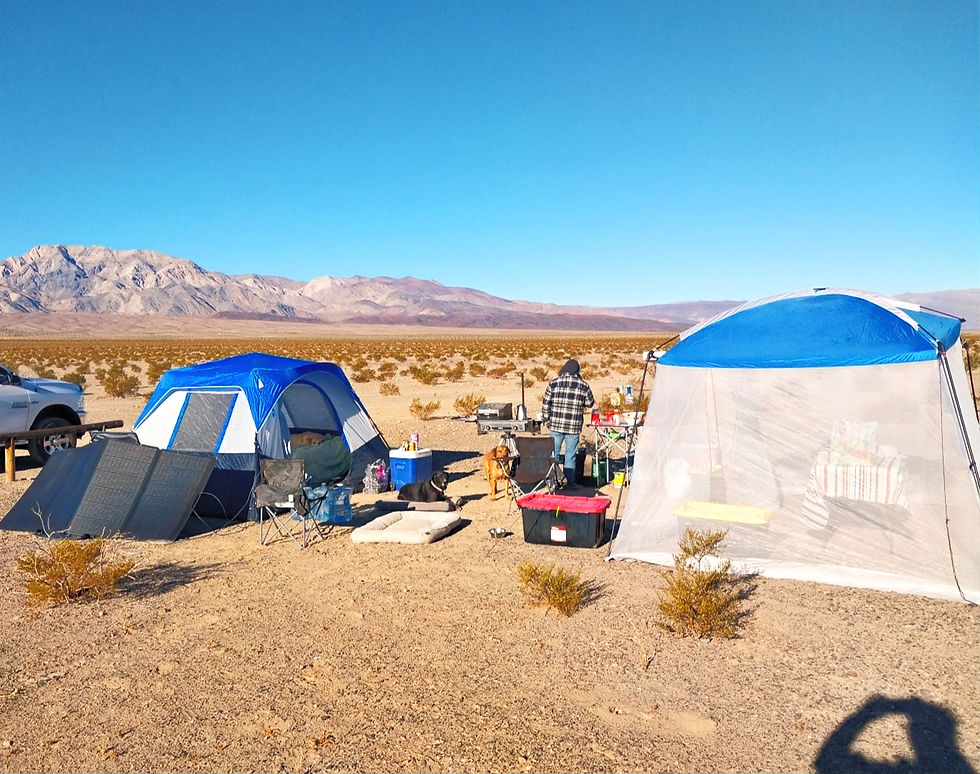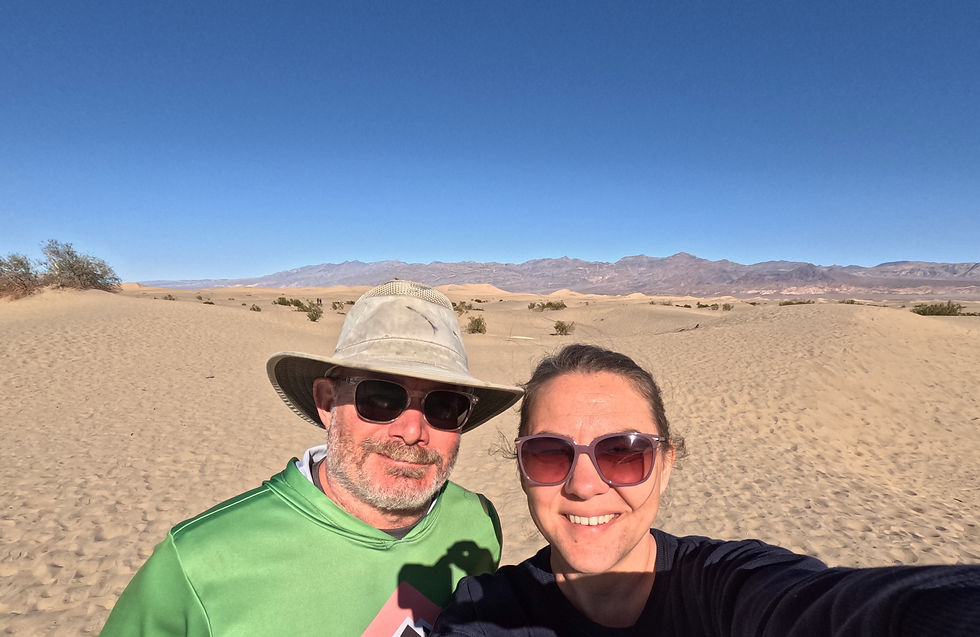Exploring Death Valley - Camping Tips, Highlights & Hidden Gems
- Cara Kerouac
- Jan 25
- 4 min read
Welcome to another adventure with Kerouac’s Cruising! This week, we’re sharing our unforgettable trip to Death Valley National Park and beyond. From prepping for the journey to exploring awe-inspiring landscapes, here’s everything you need to know about making the most of your time in one of the most unique places on Earth.
Journey Prep: Packing for Success

Before heading out, we take packing seriously—especially for a 10-day trip like this one. Here are some of our top tips:
Block Ice: Place block ice at the bottom of your cooler—it lasts much longer than cubes!
Pre-Portioned Meals: We pre-wrap veggies (spinach, radishes, broccoli) and portion out meats like steaks, chicken thighs, and ground beef into single-serving bags for convenience.
Weatherproof Storage: Durable black storage bins (with zip ties for extra security) protect your gear from dust, rain, or even snow.
Pro Tip: Buy bins from the same brand to ensure they stack properly.
Exploring Death Valley: Key Stops & Highlights
Zabriskie Point
Our first stop, Zabriskie Point, gave us an incredible introduction to the park. The sandstone formations and surrounding salt flats were like stepping onto an alien planet. This spot also offers paved walkways and trails leading to slot canyons.
Pro Tip: Visit early in the morning or near sunset to capture the best light on the textured rock formations.
Furnace Creek Visitor Center
We stopped here to chat with a ranger and pick up maps. Furnace Creek is a hub of activity and also home to the lowest elevation in North America—282 feet below sea level!
Amenities: RV hookups, water stations, restaurants, hotels, and even a golf course.
Crazy Fact: The intense heat of Death Valley is due in part to its low elevation.
Mesquite Flat Sand Dunes
Easily accessible, Mesquite Flat is the most popular sand dune area in the park. While we

didn’t catch the undisturbed “sand waves,” this spot is magical at sunrise before the crowds arrive. Death Valley is the only place in the world where you can find all five types of sand dunes, and Mesquite Flats is just one example.
The five main types of sand dunes are:
Barchan dunes
Crescent-shaped dunes with steep faces that point away from the wind. They are common in deserts.
Parabolic dunes
U or V-shaped dunes with tips that point into the wind. They form in areas with vegetation that anchors the sand.
Star dunes
Tall dunes with multiple ridges that stem from a central peak. They are formed by wind coming from all directions.
Transverse dunes
Long ridges that are more or less parallel to the coastline. They are formed when barchan dunes align together in a straight line.
Longitudinal dunes
Also known as linear dunes.
The shape of a sand dune is determined by the type of sand, the strength of the wind, and the environment.
Insider Tip: For pristine dunes, aim to be the first one there in the morning!
Panamint Valley (Our Basecamp)
We set up camp just outside the park boundaries on BLM land in Panamint Valley. It’s perfect for dispersed camping with dogs and offers breathtaking views of the mountains bordering Death Valley.
While walking from campsite to campsite, we had an unforgettable encounter—fighter jets buzzing overhead in “silent mode” before hitting the afterburners. What a thrill!
Challenges of the Desert
Camping in Death Valley isn't without its challenges. During our trip, the high winds proved to be an adventure in themselves.
Wind Prep: Secure all gear with stakes and extra rope. Be ready to repair or improvise (duct tape is your friend!).
Weather Watching: Keep an eye on forecasts, as conditions can change quickly. Freezing nights and warm sunny days can make navigating the weather an adventure in and of itself!
Tips for Your Death Valley Adventure
Timing is Everything:
Visit in the winter for mild weather (65–70°F during the day).
Early mornings or late afternoons are ideal for hiking and exploring.
Essentials to Pack:
Plenty of water (we carried 15-gallons of containers). There are refill stations at each of the villages.
Sun protection: hats, sunscreen, and sunglasses.
A detailed map, as cell service is spotty at best.
Where to Stay:
Dispersed Camping: We recommend Panamint Valley for BLM camping. However, there is an abundance of dispersed camping throughout the park along any dirt road, so long as you are a mile from the pavement, you may camp. (Do not venture off dirt roads as you may destroy delicate flora or get stuck in super soft sand.)
Developed Campgrounds: Furnace Creek and Mesquite Springs are great options inside the park.
Visited Attractions this Episode:
Zabriskie Point
Mesquite Flat Sand Dunes
Rainbow Canyon (aka Star Wars Canyon)
Why Visit Death Valley?
When we first told friends we were heading to Death Valley, we got a lot of, "Why would you go there?" Here’s why:
The unique landscapes are like no place on Earth.
Winter weather is perfect for outdoor adventures.
It’s a photographer’s dream with stunning geology, light, and textures.
Plan Your Own Adventure
Death Valley is full of surprises—from its geological wonders to its rich history and thrilling encounters. Ready to plan your trip? Check out these resources:
National Park Info: NPS: Death Valley
Additional Camping: Campendium
Join the Conversation
We’d love to hear about your experiences or questions! Share your thoughts in the comments below, or connect with us:
Instagram: @kerouacscruising
Facebook: Kerouac’s Cruising
Don’t forget to check out this episode on YouTube and subscribe for weekly travel inspiration.
Happy travels
<3Cara

Comments